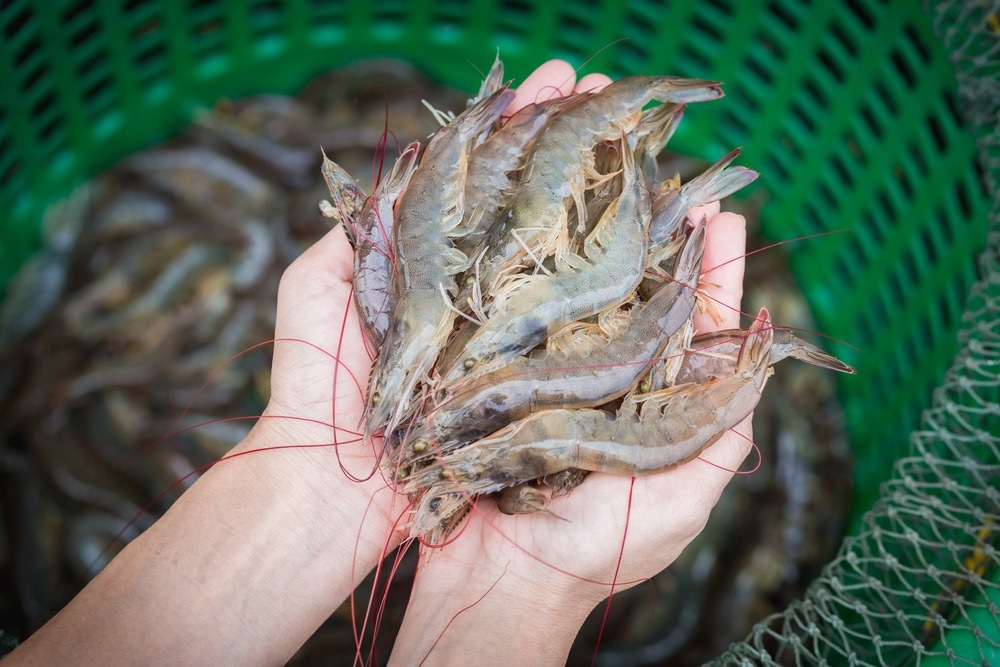White spot syndrome virus (WSSV) is a major viral infection in shrimp farming that causes significant financial impacts. Early diagnosis of the white spot syndrome virus is critical for illness prevention and therapy. However, existing technology lacks the simplicity, ultra-sensitivity, and efficiency required to create on-site detection systems for the white spot syndrome virus.

Study: Dark-field visual counting of white spot syndrome virus using gold nanoparticle probe. Image Credit: nirapai boonpheng/Shutterstock.com
A pre-proof paper from the journal Aquaculture tackles this problem by creating a gold nanoparticle-based counting approach for identifying the white spot syndrome virus with the naked eye utilizing the light scattering properties of gold nanoparticles (GNPs).
White Spot Syndrome Virus: A Dangerous Pathogen
White spot syndrome virus (WSSV) is the most damaging viral disease to shrimp production. Since the initial large-scale breakout of the white spot syndrome virus in the early 1990s, shrimp aquaculture in more than 30 nations has sustained enormous economic losses.
Over 40 types of shrimps and freshwater zooplankton are susceptible to infection by the white spot syndrome virus. White spot syndrome virus targets primarily epithelial tissue, stomach, appendages, intestinal epithelium, striated muscle, and other organs.
The origin and pathogenesis of the white spot syndrome virus are currently unknown, and there are no effective treatments for the viral infection. Detecting and blocking the transmission of the white spot syndrome virus is consequently the only effective method of protection against the illness.
Limitations of Current WSSV Detection Methods
Visual inspection, electron spectroscopy, immunotherapy, and molecular biology are the current approaches used to identify the white spot syndrome virus. The majority of existing detection methods are qualitative and unable to quantify the amount of white spot syndrome viral copies.
Although quantitative PCR (qPCR) has remarkable specificity and may be utilized for statistical identification, the equipment is costly, and the process is complex. Viral load is often assessed by qPCR detection of the replica number of a certain gene. However, previous research has shown that this approach does not accurately represent the quantity of packed mature viral proteins.
There are currently no effective treatment or control strategies for the white spot syndrome virus. The ability to monitor the viral status of farmed shrimp in real-time is critical for preventing the spread and break out of the infection. As a result, there is an immediate need to create an ultra-sensitive, quick, and simple technique to fulfill on-site detection needs.
Gold Nanoparticles for Detection of WSSV
Gold nanoparticles are increasingly being employed in the development of physiological and biochemical sensors for the detection of biomolecules, ions, and viruses. This is because small-scale probes made of gold nanoparticles have excellent dispersion and effectiveness in marking sub-micron pathogens for inspection under dark-field microscopes.
In this study, the researchers created a gold nanoparticle-labeled dark-field counting approach for detecting the white spot syndrome virus. First, antibodies against the white spot syndrome virus were employed to interact with the 15-nanometer gold nanoparticles. Then pure probes consisting of mono-dispersed gold nanoparticles were treated with the white spot syndrome virus specimen for a short period to produce a complex of WSSV and gold nanoparticles.
Important Findings of the Study
The researchers found that the 15 nm gold nanoparticles alone were undetectable in the dark field due to poor dispersion of light. However, each complex of WSSV and gold nanoparticles assumed a brilliant, gold, and elliptical shape under dark-field microscopy, making the number of the white spot syndrome virus in a specimen countable with the naked eye.
The gold nanoparticle-based dark-field counting approach is simple to implement since it only requires mixing gold nanoparticles with a specimen for a short period before dropping some of the solutions on a slide for naked-eye identification using a dark field microscope.
Furthermore, the gold nanoparticle counting approach established in this work is accurate and time-saving since the gold nanoparticle limit of detection is of the same order of magnitude as that of qPCR. Furthermore, the detection rate of a sample containing gold nanoparticles is less than a quarter of that of qPCR.
Based on these results, the gold nanoparticles-based counting approach might be employed for quick and sensitive identification of the white spot syndrome virus in clinical specimens from aquaculture systems.
Reference
Bai, Y. et al. (2022). Dark-field visual counting of white spot syndrome virus using gold nanoparticles probe. Aquaculture. Available at: https://www.sciencedirect.com/science/article/pii/S0044848622009140?via%3Dihub
Disclaimer: The views expressed here are those of the author expressed in their private capacity and do not necessarily represent the views of AZoM.com Limited T/A AZoNetwork the owner and operator of this website. This disclaimer forms part of the Terms and conditions of use of this website.